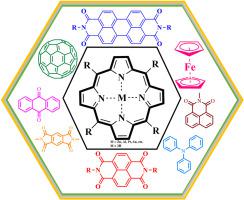当前位置:
X-MOL 学术
›
Dyes Pigments
›
论文详情
Our official English website, www.x-mol.net, welcomes your
feedback! (Note: you will need to create a separate account there.)
Porphyrin-based covalently bonded nanoarchitectonics of organic donor-acceptor system for artificial photosynthesis: A review
Dyes and Pigments ( IF 4.1 ) Pub Date : 2024-03-25 , DOI: 10.1016/j.dyepig.2024.112113 Harshad A. Mirgane , Kerba S. More , Naveena S. Veeranagaiah , Sheshanath V. Bhosale
Dyes and Pigments ( IF 4.1 ) Pub Date : 2024-03-25 , DOI: 10.1016/j.dyepig.2024.112113 Harshad A. Mirgane , Kerba S. More , Naveena S. Veeranagaiah , Sheshanath V. Bhosale

|
In the biological world, donor-acceptor (D-A) systems play an important role in natural photosynthesis, especially light harvesting-1 and -2, i.e. LH1 and LH2 systems. Scientists have been working to mimic the natural phenomenon using organic molecules called artificial photosynthesis. In D-A systems, both the donor and acceptor units are associated with π-conjugated dyes such as porphyrin, fullerene, Naphthalenediimides, perylenediimides, tetraphenylethylene, ferrocene, quinones, triphenylamine, etc. Which provide simple, effective, sensitive and selective for the development of photosynthetic reaction centres. Numerous systems have been developed to study long-lived charge separation in artificial photosynthesis. Porphyrin-based D-A systems have advantages over other systems as they are vital to natural photosynthesis. Faster energy and electron transfer, long-lived charge separation and slow recombination process and importantly, high thermal and photostability and excellent molar extinction coefficients of porphyrin analogues play a key role in the development of D-A systems for the development of artificial photosynthesis. This review brief previous two decades developments of various D-A conjugated dyads, tirades, pentads etc., which includes porphyrin as a donor and fullerene, naphthalene diimide and perylene diimide as an acceptors connected through various spacer molecules briefed from the last two decades. We also discussed optical and photophysical properties and also talk about these probes in the natural system.
中文翻译:

用于人工光合作用的有机供体-受体系统的卟啉基共价键合纳米结构:综述
在生物界中,供体-受体(DA)系统在自然光合作用中发挥着重要作用,特别是光捕获-1和-2,即LH1和LH2系统。科学家们一直致力于使用称为人工光合作用的有机分子来模拟自然现象。在DA体系中,供体和受体单元均与卟啉、富勒烯、萘二亚胺、苝二亚胺、四苯乙烯、二茂铁、醌、三苯胺等π-共轭染料缔合,为DA系统的开发提供了简单、有效、灵敏和选择性的方法。光合作用反应中心。人们已经开发了许多系统来研究人工光合作用中的长寿命电荷分离。基于卟啉的 DA 系统比其他系统具有优势,因为它们对自然光合作用至关重要。更快的能量和电子转移、长寿命的电荷分离和缓慢的复合过程,重要的是,卟啉类似物的高热稳定性和光稳定性以及优异的摩尔消光系数在用于人工光合作用的DA系统的开发中发挥着关键作用。本综述概述了过去二十年各种DA共轭二元组、三联体、五元组等的发展,其中包括卟啉作为供体和富勒烯、萘二酰亚胺和苝二酰亚胺作为受体通过过去二十年介绍的各种间隔分子连接。我们还讨论了光学和光物理特性,并讨论了自然系统中的这些探针。
更新日期:2024-03-25
中文翻译:

用于人工光合作用的有机供体-受体系统的卟啉基共价键合纳米结构:综述
在生物界中,供体-受体(DA)系统在自然光合作用中发挥着重要作用,特别是光捕获-1和-2,即LH1和LH2系统。科学家们一直致力于使用称为人工光合作用的有机分子来模拟自然现象。在DA体系中,供体和受体单元均与卟啉、富勒烯、萘二亚胺、苝二亚胺、四苯乙烯、二茂铁、醌、三苯胺等π-共轭染料缔合,为DA系统的开发提供了简单、有效、灵敏和选择性的方法。光合作用反应中心。人们已经开发了许多系统来研究人工光合作用中的长寿命电荷分离。基于卟啉的 DA 系统比其他系统具有优势,因为它们对自然光合作用至关重要。更快的能量和电子转移、长寿命的电荷分离和缓慢的复合过程,重要的是,卟啉类似物的高热稳定性和光稳定性以及优异的摩尔消光系数在用于人工光合作用的DA系统的开发中发挥着关键作用。本综述概述了过去二十年各种DA共轭二元组、三联体、五元组等的发展,其中包括卟啉作为供体和富勒烯、萘二酰亚胺和苝二酰亚胺作为受体通过过去二十年介绍的各种间隔分子连接。我们还讨论了光学和光物理特性,并讨论了自然系统中的这些探针。


















































 京公网安备 11010802027423号
京公网安备 11010802027423号